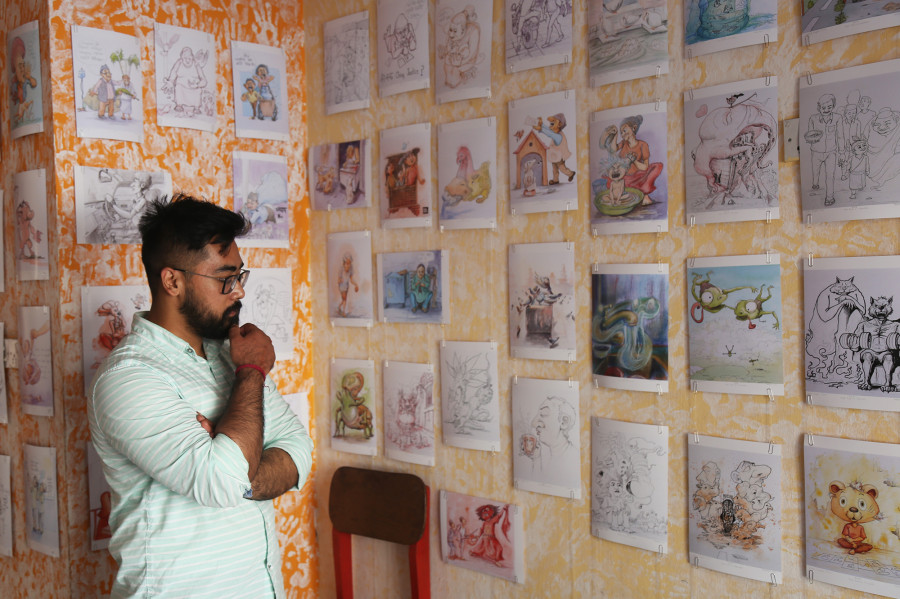Entertainment
Meet the artist who journaled his life in art
Prakash Ranjit produced one art each day for one whole year to deal with his mental health issues
Diya Rijal
A total of 365 pieces of art cover the walls at Nexus Culture Nepal, an art hub in Patan. Each art is unique, some colourful while others in black and white, following Prakash Ranjit’s journey throughout a year—each art per day.
The artist’s prints, spread from the beginning of a staircase on the ground floor leading to a room on a floor above, are a reflection of real-life events of the artist or a product of his imagination, he says.
“Most of them are based on reality. Imaginations also have its foundations on what I have seen, felt and have gone through,” says Ranjit whose exhibition is titled, 365, not just a number: Showcasing of Illustration.
The journey to documenting his everyday life started when he decided to draw illustrations to combat his mental health issues. When the artist was diagnosed with various mental health disorders—such as anxiety, depression—his therapist recommended that he keep a journal.
“But instead of writing about my feelings and emotions, I used my drawings,” he says.
Among his art, there is a strip of comics showing a character, painted in a strikingly golden colour, having a breakdown. The character’s bright colour set against a faded blue and purple background helps in clearly communicating his pain and call for help apart from the accompanying speech bubble. This artwork is a reference to the artist’s struggle with his mental illness.
His illustrations, therefore, are testament of how he felt during each day throughout the year. As every day has its own cycle of life and death, his artworks too, are varied—with the use of different mediums and colour palettes to express his inner musings.

Another one of his artworks portrays his conversation with a cobbler. It is a simple yet poignant depiction of an everyday conversation between two strangers, and how it can leave an unexpected but lasting impact.
This is also the reason why the exhibition doesn’t pertain to any particular theme. Apart from colourful and black and white pieces, most of his artworks seem to have been dominated by blue and purple shades.
According to the artist, blue represents sadness while purple, his preferred colour, represents peace.
He is consistent with the use of these colours. One of his works has an overall blue undertone, emphasising the artists’ sadness while making this piece.
Throughout the exhibition, the artist uses ink, watercolours, and colour pencils. The mix of different artforms used in this display makes it far from conventional.
“My thoughts, emotions and events of the day helped me decide on ways I wanted to express,” he says.
But his artworks aren’t just about dealing with his struggles, Ranjit has also managed to include humour in his works—mostly inspired by things he overheard in the streets.
The exhibition also offers the audience to look at the artist’s original work—spread over a number of sketchbooks. The artist sits cross-legged on the floor and even explains his inspirations and stories behind his creation.
Apart from that, the artist also engages with his audience with a session of live painting every afternoon at Nexus. He starts his painting sessions while also striking a conversation with his audience, which the artist says guides his art. While the artist is at work, it is also a platform for in-depth discussions on mental health issues, travel diaries and personal space.
“I decided to curate this exhibition because of the way it deals with mental health issues,” says Ashmina Ranjit, a conceptual artist, who also runs Nexus. “Prakash’s one-year devotion to art can also be an inspiration to others who are going through a similar situation.”
The art exhibition is open till July 7 (from 10 am till 8pm) and live performance starts at 4pm-7 pm at Nexus Cultural Nepal Bakundole, Patan.




 19.12°C Kathmandu
19.12°C Kathmandu










